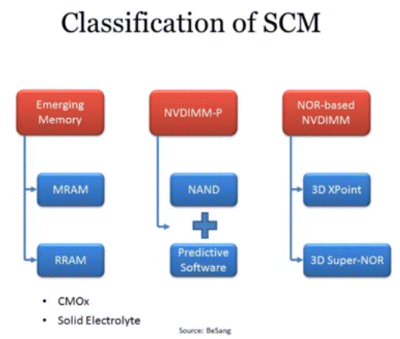BeSang , founded in 2003
and with headquarters in Beaverton, OR, is a pioneer in the design,
development, and delivery of unsurpassed TRUE 3-dimensional (3D) integrated
circuit (IC) solutions.
BeSang's cutting edge 3D IC technologies
enable stacking multiple device layers in a vertical direction and provide
ultra low-cost and high-performance solutions to CPU, DSP, ASIC, FPGA, SoC,
DRAM, SRMA, Flash, Image Sensor and Solid State Drive applications. |
| ... |
| see also:-
BeSang's technology page |
| ... |
| Who's who
in SSD? - BeSang | |
by
Zsolt Kerekes,
editor - StorageSearch.com
- September 26, 2016
I admit that I completely missed the
first 13 years of BeSang's presence in areas which may have intersected with
the SSD market.
But I woke up and started paying attention in
June 2016 - when
I saw the best competitive analysis which I had upto that time about Intel
/ Micron's (at that time fluff-ware) 3DXPoint technology.
Aha! - I
thoughtt - this CEO really seems to understand the semiconductor technologies in
this market.
BeSang is a company which is worthy of more industry
attention.
See also:-
SSD market
history |
|
| .. |
 |
| .. |
| what were
the big SSD ideas which emerged in 2016? |
"Storage Class Memory
As
storage class memories are emerging, the memory hierarchy will be changed.
NOR-based NVDIMMs, such as 3D Super-NOR and 3D XPoint, will replace DRAM and SSD
at the same time.
Also, software-based NVDIMM-P, such as HybriDIMM,
will come to the storage class memory market. Storage class memories mingles
fast-but-expensive volatile, and slow-but-inexpensive non-volatile memories
together. As a result, it will significantly boost system performance at low
cost and create huge market opportunities."
Sang-Yun Lee,
President & CEO - BeSang | | |
| .. |
|
|
| .. |
| placing 3D XPoint claims in
context |
Editor:- June 23, 2016 - If you've been trying to
renconcile Intel
/ Micron
competitive claims about
3D
XPoint compared to flash and DRAM - it has been problematic due to absence
of adequate hard data.
A new video -
3D XPoint, reality,
opportunity, competition - by Sang Yung Lee,
President & CEO - BeSang
- places the known features of 3D XPoint into context, and looks at the
limitations, manufacturing costs and best likely application roles for this new
technology.
If you're interested in analyzing the impact of
DIMM wars
in your future plans - then the 12 minutes you spend listening to the narrative
in this video will remove any mysteries of how the IM technologies could fit
into the pattern of adoption and just as important - you'll see where 3D XPoint
is unlikely to be the best fit technology too. ...watch the video | | |
| .. |
|

| |
| BeSang has been gaining
more attention for its ideas about the best way to design and make high density
next generation nand flash. In Q4 2017 BeSang was the 26th most popular
company followed up by readers of StorageSearch.com |
| Top SSD Companies in Q4
2017 | | |
| .. |
|
|
| .... |
 |
| .... |
| SCM -
competing semiconductor approaches compared |
Editor:- January 10, 2017 - In a new video
Storage Class Memory -
Reality, Opportunity, and Competition - Sang-Yun Lee,
CEO - BeSang
presents his analysis of the technology SWOT state of the market.

Among
other things Sang-Yun Lee (whose company offers 3D super-NOR as an alternative
competing SSD and SCM technology platform) notes the weaknesses of some
competing technologies:-
- when looking at cross-point structure memories (such as
Micron's 3DXpoint) - "is
the worst nightmare for manufacturing"
- when looking at NVDIMM-P (such as
Diablo's Memory 1) - "performance
is not predictable at all times"
Editor's comments:- In
some significant areas I disagree with the finality of some of of Mr. Lee's
conclusions.
For example I think that changes in system aware
software can improve the usability of nand flash as DRAM. This is because I
think the applications experience leans more heavily towards the elastic
behavior of the entire "virtual" memory system as a working model
rather than transmitting every bump in the road from the native physical memory
(even when that memory is DRAM) for reasons discussed
here.
Also when it comes to concern about the
endurance of
nand flash when used in DRAM emulation - I am satisfied that due to the
variability of DRAM data churn (which follows a time and fractional data change
pattern in real applications - rather than all DRAM contents being equally
turbulent) and provided that the emulated data capacity is big enough (and
supported by a suitably sized
RAM cache ratio)
then I think that flash endurance is good enough for reasons discussed
here.
On
the other hand - due to the fact that SCM applications currently require a
great deal of characterization and testing and may require proprietary tuning -
and due to the
diverse
nature of risk / reward attitudes in the enterprise user base (which we
already see when it comes to memory systems) I expect fragmentation will
occur in SCM adoption.
On the one hand there will be those who are
satisfied with the risks posed by software enhanced DRAM emulation (because
they have the technical resources to assess the risks and have applications
which match the software supported by early SCM solutions).
And on
the other hand there will be many who prefer to wait to get solutions which
rely more on native hardware and rely less on the magic promised by new
software data architectures.
When memory technologies change then
systems designers have to invest learning time to understand the implications of
competing offers. And whatever your background Sang-Yun Lee's presentation
will get you thinking about many important comparative technology issues
...see the video
See
also:- the SSD heresies | | |
| .. |
|
| |





